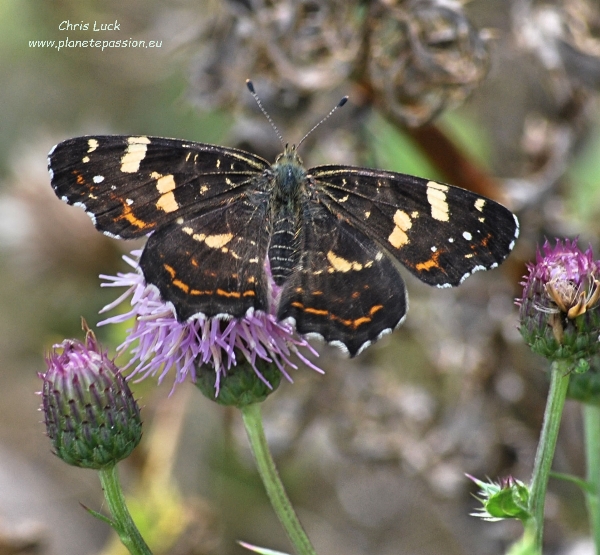
A small selection of insects that use thistles.
Thistles are considered to be a plant pest where agriculture is concerned and there are even laws in France to hold people responsible for removal from their land or at least preventing them from setting seed and yet they are incredibly important for bees about which we hear so much. Creeping thistle in our fields buzzes with bees when they are in flower and a picture of a bee on a thistle was even used in a French Government brochure about “saving our bees”.

ABOVE: Andrena flavipes on Creeping Thistle.
Andrena flavipes is one of our more common mining bees to be found in a variety of open habitats. They nest singly or more likely in congregations giving the appearance of a colony. Nests are made in clay or sandy soils in open or sparsely vegetated sunny situations. First generation can be hatched as early as the end of February in mild regions with a second generation from the end of June.

ABOVE: Anthidium species, poss Anthidium cingulatum on Teasel

ABOVE: Anthidium florentinum on Spear Thislte
Anthidium cingulatum and Anthidium florentinum are two of the species of carder bee that are present in France. Female Carder bees use existing holes or crevices to make their nests that are lined and sealed with dense velvety hairs from the leaves of certain plants. Males patrol and guard territories where there are suitable plants for the females in the hope that they will be the one that gets to mate with them.

ABOVE: Brown Hairstreak butterfly on Creeping thistle
The Brown Hairstreak is the largest hairstreak in France and a species that tends to occupy the same area year after year where it is established providing its larval food plant, principally Blackthorn, is present and not over managed. They spend a lot of their time basking high up in trees. There is one generation a year which can be seen from the start of July and the species winters in the egg stage.

ABOVE: Buff-tailed-bumble-bee on Spear thistle
The Buff tailed Bumblebee is one of the commonest Bumble bees in France and usually the first to be seen in late winter / early spring. As the Latin name Bombus terrestris implies it is a species that tends to make its nest in the ground using an existing tunnel or cavity, frequently in the base of a stone wall in France where mice have created a tunnel. Colonies can contain several hundred bees and only young newly fertilised Queens over winter hibernating somewhere dry and not too cold.

ABOVE: Carpenter bee Xylocopa violacea on Wooly thistle
The Carpenter bee Xylocopa violacea is the largest solitary bee in Europe and despite their scary size they are really quite timid. Unusually both males and females over winter and then breed in May / June. Females make their nest in degraded old logs, dead trees and branches etc. and normally an existing hole is used. A single entry hole leads into multiple galleries into which the female lays her eggs, each one blocked in with a pellet of pollen which provides nutrition for the larva. The adults emerge in late summer.

ABOVE: Carpocoris purpureipennis on Spear thistle - France
Carpocoris purpureipennis is a shield bug that is usually found in natural meadows and grasslands on thistles and Apiaceae (or Umbelliferae), commonly known as the celery, carrot or parsley family.

ABOVE: Holly blue butterfly and Paper wasp on Creeping thistle
The Holly blue, (Ilex aquifolium), butterfly is widespread in France with two generations a year. As the name implies the caterpillars are frequently found on Holly although Bramble, Spindle, Ivy and Gorse are equally popular. There are two generations a year and they over-winter as pupa often suspended under a leaf.

ABOVE: Eristalis-tenax hoverfly on creeping thistle
Eristalis-tenax is one of the more common hoverflies in France and the larva are the rat-tailed maggots that live and develop in drainage ditches, pools around manure piles, sewage, and similar places containing water badly polluted with organic matter. The larvae leave the water to pupate and once hatched the adults feed on the nectar from a number of flowers; again the Apiaceae (or Umbelliferae) are often favoured. They mainly over winter as adults in cavities and other sheltered places.

ABOVE: Halictus-scabiosae on tuberous thistle
Halictus-scabiosae is a common mining bee that nests in hardened bare or sparsely vegetated soil, footpaths or poor lawns would be typical. Females make vertical shafts with galleries to place their eggs in. It’s an interesting solitary species in so much as more than one female may share the same tunnel. The nests are susceptible to Sphecodes gibbus a cuckoo bee that puts its eggs in the solitary bees nest.

ABOVE: 2nd generation Map butterfly on Creeping thistle
The Map butterfly is best-known for having two distinctly different forms, levana and prorsa that represent the spring and summer generations. Spring form - levana are primarily orange in colour, giving them the appearance of a small fritillary, whereas the summer form - prorsa individuals look more like a very small White Admiral. Caterpillars feed on Stinging nettle and over-winter as pupa.

ABOVE: Swallowtail butterfly on Spear thistle
The Swallowtail butterfly can be found in a huge range of habitats in France including in towns and cities. Caterpillars feed on many species of the Umbelliferae with carrot and fennel leaves being top of the list in gardens where they don't eat enough to cause harm. They over-winter as pupa.


